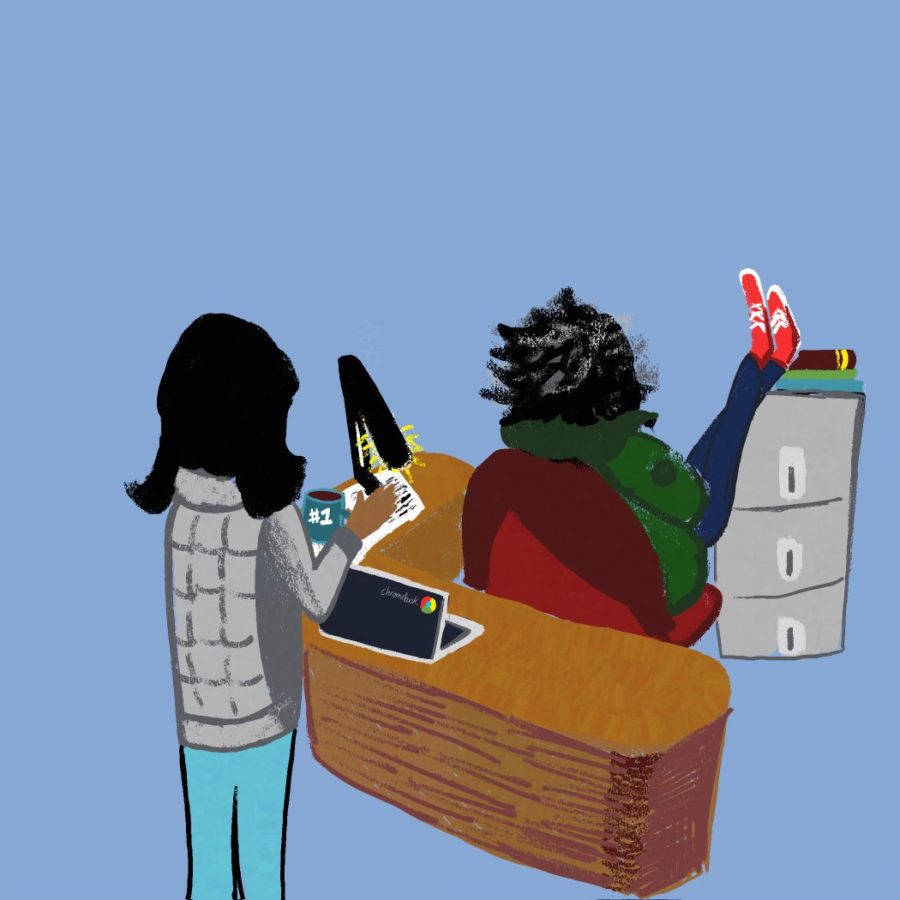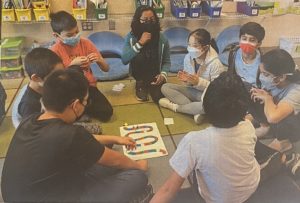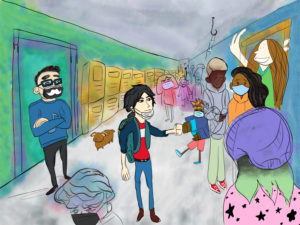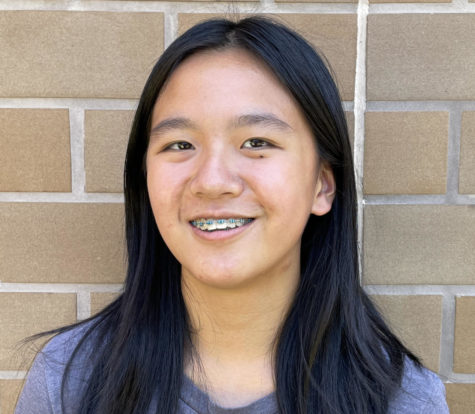Dear teachers, stop treating our concerns like an inconvenience
Teachers should not turn a blind eye to the struggles of students.
February 25, 2023
After a short game of “not it” to see who we shall sacrifice, I am chosen as “tribute”. With a short gulp, I apprehensively walk towards the teacher’s desk. Maintaining zero eye-contact as a shield of armor, I hope the journey takes longer – I haven’t even thought of how to pose the question. But alas, within a few short steps I have already arrived.
I ask, then I wait.
I wait. And I hope that they don’t roll their eyes again. I hope to be that one student at whom they don’t sigh. Or scowl. And so I wait.
I cross my fingers and hope that I’ve asked a “smart” question and that this time I’ll actually get a plausible answer instead of returning to my seat with the bare minimum.
For what it is worth, I have fun recounting such experiences to my friends. The inability to ask questions in class, being scared of some of our teachers, being stressed out because we are being told of tests almost at the last minute. We dramatize these experiences and use them as discussion points and entertainment when they are in hindsight.
But unfortunately, these situations aren’t something to use for entertainment nor for light conversation. These experiences should be used by some of our teachers as points to ponder on.
Aptly nicknamed a “pressure cooker,” Dougherty Valley High School (DVHS) is a school for which the description “competitive” is an understatement. Students prioritize academic success over anything else, including our health. While parental and peer pressure play a role in this toxicity, sadly our partners in learning: our teachers, do too.
Just last year, former teacher Barnholdt made a few statements praising DVHS during an interview. While comparing Asian and white students’ academic drive to African-American and Hispanic students’ lack thereof he stated that he found DVHS as a blessing, implying that the large number of Asian and white students at this school made teaching easier for him.
Observations like this that are meant to push a group up at the cost of another group are not healthy. While this statement may seem uplifting for one race, it only further alienates and dehumanizes the other races. It also burdens the races being complimented with more expectations and stereotypes. Although DVHS has a multi-racial student body, some teachers reflect Barnholdt’s expectations towards the entire student body while generalizing the campus body to be mainly Asian or white.
Student Max* explains, “Everyone knows the tests and AP classes here are [much] harder because everyone already excels. We’re held up to this expectation: you have to succeed.”
To achieve these high levels, the academic responsibility is placed more so upon students than on teachers. Just as Barnholdt viewed DVHS as a blessing because he did not need to put in as much effort to teach, there are many more teachers at DVHS who feel and act similarly.
They will only lecture, assign work, and then become completely unapproachable for students who need extra help. These teachers unconsciously become unapproachable by creating an anxious environment.
Max continues, “I’ve [always] had trouble approaching teachers because of a fear of judgment. Teachers in the past have been annoyed [and] given me looks [as to say], ‘Is she done now?’ [Once] I asked a teacher if I could go over the [test] answers [after class ended]. I didn’t ask [during class because] I was nervous to speak up, I didn’t want the people around me to think, ‘She got all of these [questions] wrong.’ Then [the teacher] got upset and said, ‘Why are you asking now? You’re inconveniencing me.’ I felt trapped there.”
And this is not a lone experience.
Another student, Rem*, adds on, “I don’t feel comfortable asking for help. Because when I do, there have been teachers at our school that just shake their heads, roll their eyes and look really frustrated or annoyed. It upsets me because they make me feel insecure [about learning].”
A student asking for help should never be an inconvenience. It should be something to value. After all, through struggle we learn and grow.
But of course, DVHS does not have an amicable relationship with growth. The high standards that parents and peers enforce are carried forward by certain teachers. Struggle is never rewarded here, it is dehumanized and seen as weaker.
Student Lake* explains, “For AP classes, I’ve had teachers straight up say at the start of the year, if you have not taken this course, you are going to fail if you stay in this class. Obviously, it’s important for the teacher to express the level of knowledge and rigor you need for the class. But there are better ways to phrase it. I’ve had other teachers who’ve said the same thing in a polite way: stating the basic facts like ‘Students that don’t have these prerequisites typically find it harder.’ And the teacher is the one who’s supposed to encourage you. So when teachers say, ‘You’re not going to make this class,’ it adds on to the toxic DV culture.”
When struggle is not supported it is not seen as necessary to academic success. In this cutthroat race towards glistening grades, struggle goes out the window and with it so do growth and learning. The only alternative left for students is to cheat.
Max explains, “Students at DV, we’re supposed to get the grade. And how do we get the grade? [We] learn how to be better cheaters.”
Another student, Rin*, adds on, “I think when it comes to tests or even homework – I don’t understand how some teachers grade homework unnecessarily hard. Homework is supposed to be for practice. Why are you marking students off if they make a mistake? I think that’s one of the ways teachers feed this constant need of being at your top hundred percent. Because then it just facilitates cheating: they’re not learning anymore, they’re just trying to get the right answer.”
On a personal account, I know countless peers who’ve submitted to cheating in order to raise their grades, especially in classes where teachers set a firm barrier between the students and themselves. Often, there are group chats where students from earlier periods share their test questions with upcoming periods or where an excelling student provides their answers to help their peers. If little support is provided by teachers, students begin to rely on each other and that often involves academic dishonesty.
Beyond the academic nitty-gritties, when certain teachers provide nothing but stress for their students, high school becomes an isolating and suffocating journey. Something no young adult should have to go through, especially when a school should be akin to a second home.
So what can we do?
First, I would like to acknowledge the fact that teaching is hard. Having experience as a tutor, I realize how exhausting it must be to teach adolescents 24/7. But that cannot and should not stop teachers from trying their best for their students.
It is important to build a positive learning community where students feel safe to make mistakes. We are maturing from adolescents into independent adults and part of this journey is learning how to confidently voice our concerns.
So let’s work from the exterior – the classroom appearance – inwards.
Lake explains, “I’ve actually had multiple teachers who decorated their classrooms prettily. And just walking into that environment puts a little smile on [my] face.”
Educators should build a climate of trust where students are unafraid to express themselves. While teachers should not be students’ friends, they also should not be the bane of a student’s existence. Carefully using words and actions that communicate that an educator’s goal to lift their students up is essential to this process.
Max says, “An example [of a constructive environment] is my Chinese class where probably ninety-five percent of the people are native speakers. And they grew up speaking Chinese, while [I am] the opposite. But I feel really confident and eager to learn in that class, because when I don’t understand, there’s no judgment around it. People are really open to helping me, especially with my teacher. She has this mindset that she shares with the class: ‘You’re improving, and you’re trying, and you’re learning. Keep asking questions, because I want you to grow and learn the content and our language.’”
“The biggest thing that makes a positive environment, for me, is my ability to express myself and express my concerns and let people know I’m struggling without them [seeing] me as weak or less,” Max concludes.
Instead of brushing a concern aside, educators should encourage students to continue asking questions and working through the problem. They can do this with words of support and providing the resources necessary for development.
“I feel like as a teacher, it’s important to encourage students and make sure that the students understand that if they’re not understanding something, it’s not the students fault. And it might also not be the teacher’s fault. But express ways that the student can get help [instead of] just putting the student down. I think [one of] the main roles of a teacher is building confidence,” adds Lake.
Including quarterly or semester-based student feedback forms that are completely anonymous – hand-written and submitted through an “under the door” method – could be a way for teachers to learn how their students are perceiving the environment they’ve created. Then teachers could take steps from there to either continue that practice or try something new.
Where parents and peers expect students to fly through an educational career with ease, it doesn’t have to be the same for teachers. Yes, the toxic DVHS culture is a multi-layered problem. But that shouldn’t stop educators from trying.
We come to you because we feel lost, because we need to clear our doubts, because we’re new to certain concepts and most importantly because we’re your students.
Teachers have the unique opportunity of creating a safe space for their students with the rules they set and the way they present themselves. Their classrooms can be very effective in either making or breaking a student. And if we truly want to prioritize student growth and success in these learning environments, it’s time that teachers start working towards the former.
*Names have been changed






